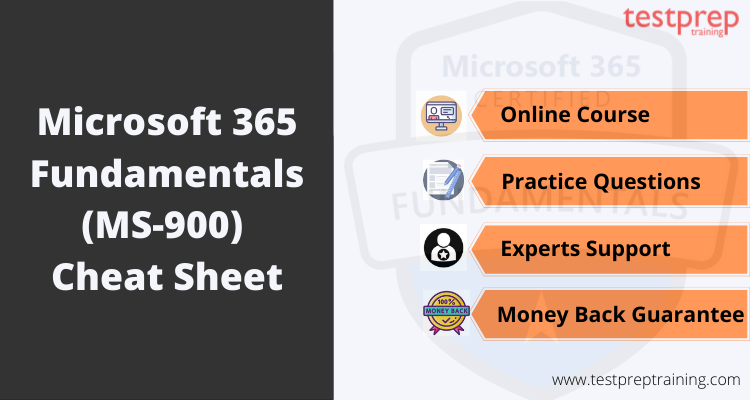Microsoft 365 is a set of online tools and services that can help organizations work better together and get more done. MS-900 is a certification test that checks how well you understand Microsoft 365 and its parts. Passing this test shows you know the main ideas and good things about Microsoft 365, and that you can use its different tools and services. MS-900 is the only test you need to get the Microsoft 365 Fundamentals certification.
Afterward, you can choose to take other tests in the Microsoft 365 Paths if you want. This test is for people who want to show they understand the basics and the Software as a Service cloud model. The test covers a wide range of topics about the options and benefits of using Microsoft 365 cloud services.
This cheat sheet is a helpful tool for getting ready for the MS-900 certification test. It offers a fast and easy way to look up important ideas, subjects, and terms you need to understand. It covers everything from the basics of Microsoft 365 to more advanced topics like managing who has access, keeping things secure, following rules, and making sure everything is in order. Whether you’re aiming to pass the MS-900 test or just want to boost your understanding of Microsoft 365, this cheat sheet is a valuable resource. It lets you quickly and easily find the most important information. So, let’s start using it!
Glossary for Microsoft 365 Fundamentals (MS-900) Terminology
Here are some common terms and definitions related to Microsoft 365 Fundamentals (MS-900):
- Microsoft 365: A cloud-based suite of tools and applications that includes Office 365, Windows 10, and Enterprise Mobility + Security.
- Office 365: A cloud-based suite of productivity applications, including Word, Excel, PowerPoint, and Outlook.
- Azure: A cloud computing platform and service offered by Microsoft that allows users to build, deploy, and manage applications and services through a global network of data centers.
- SharePoint: A web-based collaboration platform that allows users to store, organize, and share information with others.
- OneDrive: A service in the cloud where you can save and exchange files and documents.
- Teams: A collaboration platform that integrates chat, video conferencing, file sharing, and project management.
- Exchange: A messaging and collaboration platform that includes email, calendar, and contact management.
- Skype for Business: A platform for talking to others that includes sending messages right away, making audio and video calls, and having meetings online.
- Power Platform: A suite of tools and services that allows users to build custom business applications and automate workflows.
- Dynamics 365: A group of business software tools that work on the internet, helping with things like managing resources and keeping track of customers.
- Microsoft Intune: A cloud-based mobile device management (MDM) solution that allows users to manage and secure mobile devices and apps.
- Microsoft Graph: A unified REST API endpoint for accessing data across Microsoft 365 services.
- Azure Active Directory (Azure AD): A cloud-based identity and access management service that provides authentication and authorization for users and applications.
- Security and Compliance Center: A unified portal that allows users to manage security and compliance across Microsoft 365 services.
- Microsoft Stream: A secure video sharing service that allows users to upload, share, and manage videos for internal use.
How to prepare your own Microsoft 365 Fundamentals (MS-900) Cheat Sheet?
Preparing a cheat sheet can be a helpful way to study for the Microsoft 365 Fundamentals (MS-900) certification exam. Here are some steps you can follow to prepare your own cheat sheet:
- Understand the Exam Objectives: Take a look at the exam objectives listed on Microsoft’s official website to fully understand what topics will be included in the exam.
- Organize Your Notes: Gather your notes from class, online courses, textbooks, and other resources. Organize them in a way that is easy for you to understand and follow.
- Focus on Key Topics: Identify the key topics that are likely to be on the exam. These may include cloud concepts, core Microsoft 365 services and concepts, security, compliance, privacy, and pricing and support.
- Create a Visual Representation: Use diagrams, flowcharts, and other visual representations to help you understand complex topics such as identity and access management or Microsoft 365 subscriptions.
- Use Mnemonics: Develop a system of mnemonics to help you remember important concepts or lists of information. For example, you could create an acronym for the core Microsoft 365 services: E-mail (Exchange Online), Chat (Teams), Collaboration (SharePoint), and Productivity (Office Online).
- Review Regularly: Regularly review your cheat sheet to reinforce your knowledge and identify any areas that need further study.
Remember that creating a cheat sheet is not a substitute for studying the material thoroughly. Use your cheat sheet as a tool to help you organize and reinforce your knowledge, but be sure to also review other resources, practice questions, and hands-on experience to prepare for the exam.
Exam preparation resources for Microsoft 365 Fundamentals (MS-900) exam
Here are some official exam preparation resources for the Microsoft 365 Fundamentals (MS-900) exam:
- Microsoft Learn: Microsoft offers a comprehensive learning platform called Microsoft Learn that provides free training courses, interactive tutorials, and hands-on labs for various Microsoft technologies. You can find the Microsoft 365 Fundamentals learning path here: https://docs.microsoft.com/en-us/learn/paths/m365-fundamentals/
- Exam Reference book: Microsoft offers an Exam Reference book that covers all the topics that are covered in the exam. This book is available in both digital and print formats. You can find the Exam Reference book for MS-900 here: https://www.microsoft.com/en-us/learning/exam-ms-900.aspx
- Practice test: Microsoft provides a practice test for MS-900 to assist you in getting ready for the exam. This practice test consists of 40 multiple-choice questions that resemble the ones you’ll face in the real exam. You can purchase the practice test here: https://www.microsoft.com/en-us/learning/exam-ms-900.aspx
- Microsoft Official Courseware (MOC): Microsoft offers an official courseware for MS-900 that covers all the topics that are included in the exam. This courseware is designed for IT professionals who want to gain a better understanding of Microsoft 365. You can find the MOC for MS-900 here: https://www.microsoft.com/en-us/learning/course.aspx?cid=MS-900T01
- Exam study groups: Microsoft offers official exam study groups that are designed to help you prepare for the exam. These study groups are led by Microsoft Certified Trainers (MCTs) and are conducted online. You can find the exam study groups here: https://trainingsupport.microsoft.com/en-us/mcp/forum/mcp_exams
What is MS-900 Exam?
If there is something you can’t miss about your exam, then it’s surely the exam details. In other words, details play a pivotal role be it exam details or any other details. Therefore, it is always good to have details beforehand in order to secure a safe spot in the exam. The details for Microsoft MS-900 are available below:
The Microsoft MS-900 exam questions will range between 46-60 of type multiple-choice and multi-responsive questions that need to be completed in a time frame of 85 minutes. The candidate has to score at least 700 or more points in order to pass the exam. Further, the exam costs $900 USD with additional taxes. Above all, the exam is available in two language i.e. English and Japanese.
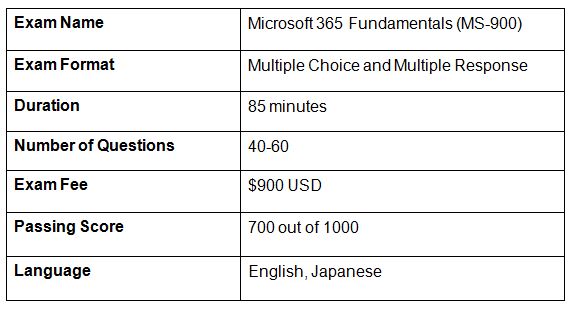
Microsoft 365 Fundamentals MS-900 Exam Outline
The Microsoft MS-900 certification exam covers the following topics:
MODULE 1 – Describe Cloud Concepts (5-10%)
Describe the different types of cloud services available
- Describe Microsoft software as a service (SaaS), infrastructure as a service (IaaS), and platform as a service (PaaS) concepts and use cases (Microsoft Documentation – What is Platform as a service (PaaS)? , What is Infrastructure as a service (IaaS)?)
- Describe differences between Office 365 and Microsoft 365
Describe the benefits of and considerations for using a cloud , hybrid, or,on-premises services
- describe public, private, and hybrid models (Microsoft Documentation – What are public, private, and hybrid clouds?)
- compare costs and advantages of cloud, hybrid, and on-premises services (Microsoft Documentation – (Cloud storage vs. on-premises servers and Comparison of cloud and on-premises features)
- Describe the concept of hybrid work and flexible work
MODULE 2 – Describe Microsoft 365 Apps and Services (45-50%)
Describe productivity solutions of Microsoft 365
- Describe the core productivity capabilities and benefits of Microsoft 365 including Microsoft Outlook and Microsoft Exchange, Microsoft 365 apps, and OneDrive (Microsoft Documentation – Describe productivity solutions of Microsoft 365, Describe Microsoft 365 apps and services)
- Describe core Microsoft 365 Apps including Microsoft Word, Excel, PowerPoint, Outlook, and OneNote (Microsoft Documentation – Office applications details, About Microsoft 365 Apps in the enterprise)
- Describe work management capabilities of Microsoft 365 including Microsoft Project, Planner, Bookings, Forms, Lists, and To Do (Microsoft Documentation – Microsoft 365 suite features, Microsoft Project, Planner, To Do, or the Tasks app)
Describe collaboration solutions of Microsoft 365
- Describe the collaboration benefits and capabilities of Microsoft 365 including Microsoft Exchange, Outlook, SharePoint, OneDrive, and Stream (Microsoft Documentation – Describe collaboration solutions of Microsoft 365, Collaborating with Teams, SharePoint, and OneDrive)
- Describe the collaboration benefits and capabilities of Microsoft Teams and Teams Phone (Microsoft Documentation – Welcome to Microsoft Teams, Use Microsoft Teams for collaboration, Phone System features)
- Describe the Microsoft Viva apps (Microsoft Documentation – Microsoft Viva service description, Viva Insights app in Teams and on the web)
- Describe the ways that you can extend Microsoft Teams by using collaborative apps
Describe endpoint modernization, management concepts, and deployment options in Microsoft 365
- Describe the endpoint management capabilities of Microsoft 365 including Microsoft Intune (Configuration Manager and co-management, Endpoint Analytics, and Windows Autopilot)
- Compare the differences between Windows 365 and Azure Virtual Desktop
- Describe the deployment and release models for Windows-as-a-Service (WaaS) including deployment rings (Microsoft Documentation – Overview of Windows as a service, Manage Windows as a service using Configuration Manager)
- Identify deployment and update channels for Microsoft 365 Apps (Microsoft Documentation – Overview of update channels for Microsoft 365 Apps, Change the Microsoft 365 Apps update channel)
Describe analytics capabilities of Microsoft 365
- Describe the capabilities of Viva Insights (Microsoft Documentation – Viva Insights app in Teams and on the web)
- Describe the capabilities of the Microsoft 365 Admin center and Microsoft 365 user portal (Microsoft Documentation – Overview of the Microsoft 365 admin center, Microsoft 365 feature descriptions)
- Describe the reports available in the Microsoft 365 Admin center and other admin centers (Microsoft Documentation – Microsoft 365 Reports in the admin center, Microsoft 365 Reports in the admin center – Microsoft 365 Apps usage)
MODULE 3 – Explain Security, Compliance, Privacy, and Trust in Microsoft 365 (25-30%)
Describe identity and access management solutions of Microsoft 365
- Describe the identity and access management capabilities of Microsoft Entra ID
- Describe cloud identity, on-premises identity, and hybrid identity concepts (Microsoft Documentation – What is hybrid identity with Azure Active Directory?, Azure Active Directory Hybrid Identity Design Considerations)
- Describe how Microsoft uses methods such as multi-factor authentication (MFA), self-service password reset (SSPR), and conditional access, to keep identities, access, and data secure
Describe threat protection solutions of Microsoft 365
- Describe Microsoft Defender XDR, Defender for Endpoint, Defender for Office 365, Defender for Identity, Defender for Cloud Apps, and the Microsoft Defender Portal (Microsoft Documentation – What is Microsoft 365 Defender?, Microsoft 365 Defender portal, Microsoft Defender for Endpoint, Microsoft Defender for Endpoint in Microsoft 365 Defender, Microsoft Defender for Office 365)
- Describe Microsoft Secure Score benefits and capabilities (Microsoft Documentation – Microsoft Secure Score)
- Describe how Microsoft 365 addresses the most common threats against endpoints, applications, and identities (Microsoft Documentation – Protect against threats, Threat investigation and response)
Describe trust, privacy, risk, and compliance solutions of Microsoft 365
- Describe the Zero Trust Model
- Describe Microsoft Purview and compliance solutions such as insider risk, auditing, and eDiscovery (Microsoft Documentation – Describe the eDiscovery and audit capabilities of Microsoft Purview)
- Describe Microsoft Purview Information Protection features such as sensitivity labels and data loss prevention (Microsoft Documentation – Protect your sensitive data with Microsoft Purview)
- Describe how Microsoft supports data residency to ensure regulatory compliance
- Describe the capabilities and benefits of Microsoft Priva (Microsoft Documentation – Learn about Microsoft Priva)
MODULE 4 – Describe Microsoft 365 Pricing, licensing, and Support (10-15%)
Identify Microsoft 365 pricing and billing management options
- Describe the pricing model for Microsoft cloud services including enterprise agreements, cloud solution providers, and direct billing (Microsoft Documentation – Cloud Solution Provider program, Cloud Solution Provider program guide, agreements, price lists, and offers)
- Describe available billing and bill management options including billing frequency and methods of payment (Microsoft Documentation – Understand your bill or invoice for Microsoft 365 for business)
Identify licensing options available in Microsoft 365
- Describe license management (Microsoft Documentation – Understand subscriptions and licenses in Microsoft 365 for business)
- Describe the differences between base licensing and add-on licensing (Microsoft Documentation – Microsoft 365 pricing, licensing, and billing options)
Identify support options for Microsoft 365 services
- Describe how to create a support request for Microsoft 365 services (Microsoft Documentation – Describe support offerings for Microsoft 365 services)
- Describe support options for Microsoft 365 services
- Describe service level agreements (SLAs) including service credits (Microsoft Documentation – Service Level Agreements (SLA) for Online Services)
- Determine service health status by using the Microsoft 365 admin portal or the Microsoft Entra Admin portal (Microsoft Documentation – check Microsoft 365 service health, Service health and continuity)
Microsoft MS-900 Study Guide: Cloud Computing Services
The goal of cloud computing is to simplify and enhance business operations, whether it’s a small startup or a big corporation. Every business has its own distinct requirements, and cloud computing providers offer a variety of services to meet those needs. Additionally, it’s crucial to comprehend the difficulty of the MS-900 exam. So, let’s get started with the preparation guide and notes.
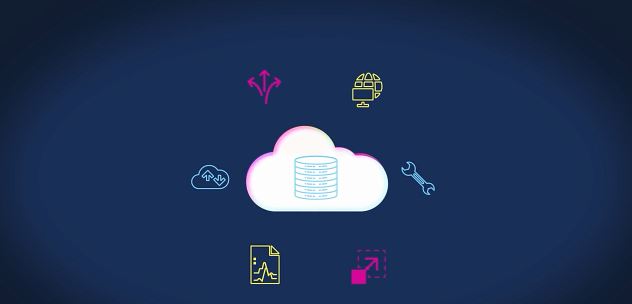
Whenever we talk about cloud computing, there are three major categories that break into the conversation. It is important to understand them because they are used in conversation, documentation, and training. So, let’s start a brief introduction to cloud computing services.
Infrastructure as a service (IaaS)
Infrastructure as a Service (IaaS) is the most flexible category of cloud services. The goal of this service is to give you maximum control over the hardware that runs your application, such as servers, virtual machines, storage, and operating systems. Instead of purchasing this hardware, you simply rent it. It’s like having instant access to a computer system that’s managed over the internet. IaaS is typically used in the following situations:
- Migrating workloads: Firstly, IaaS facilities are managed in a similar way as on-premises infrastructure. They provide an easy migration path for moving existing applications to the cloud.
- Test and development: Subsequently, teams can quickly set up and dismantle test and development environments, bringing new applications to market faster. IaaS plays a crucial role in making scaling development and testing environments, fast and economical.
- Storage, backup, and recovery: Many organizations don’t fully consider the costs and challenges of handling storage. It involves having skilled people to handle data and follow legal rules. IaaS can help manage changing storage needs and make backup and recovery systems easier to plan and manage.
Getting started with Microsoft 365 (MS-900), Use the Study Guide!
Platform as a service (PaaS)
PaaS is great for setting up an environment to create, test, and launch software applications. Its main goal is to make it easier to build an application without having to worry about the technical stuff underneath. For example, if you use PaaS to deploy a web app, you don’t need to bother with installing an operating system, web server, or doing system updates.
PaaS is commonly used in the following scenarios:
- Development framework:
- To simplify, PaaS offers a framework for developers to build or tweak cloud-based apps. It’s like using pre-made tools in Microsoft Excel macros. With PaaS, developers can create apps using ready-made software parts, which means less coding work. Plus, it comes with cloud features like scalability and reliability built-in.
- Analytics or business intelligence: Moreover, the tools available with PaaS as a service help organizations examine and dig into their data. This helps them discover trends, patterns, and make predictions to make smarter business choices like predicting future trends, designing products, and improving investments.
Software as a service (SaaS)
SaaS is a kind of software that’s hosted and managed in one place for all users. It’s like having one version of the software that everyone can use, and you pay for it with a monthly or yearly subscription. Common examples of SaaS software include Office 365, Skype, and Dynamics CRM Online.
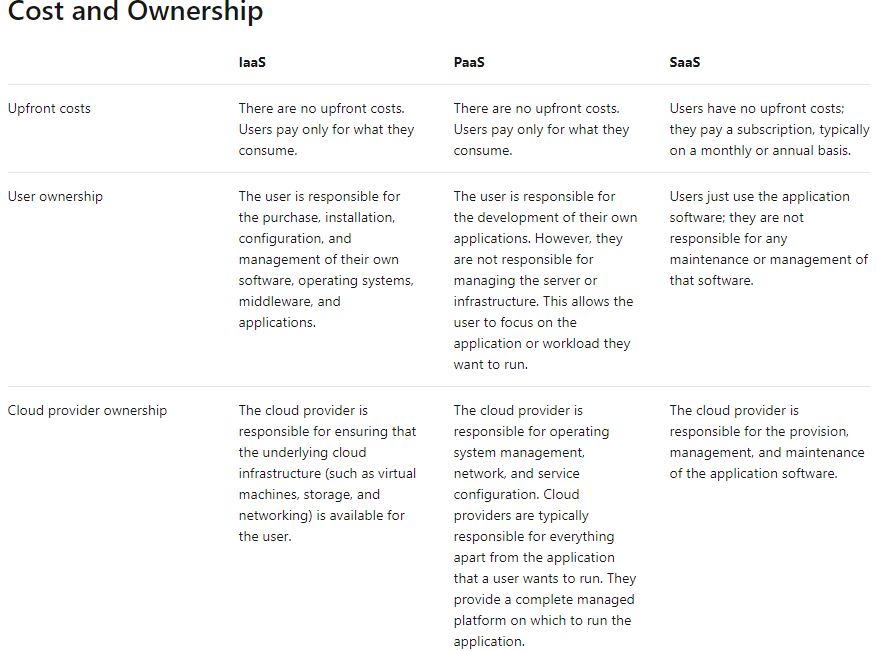
Management responsibilities
Think of these categories (IaaS, PaaS, and SaaS) like layers. PaaS adds a layer on top of IaaS, making things simpler for developers by hiding some details. However, this also means giving up some control over the hardware underneath.
Here’s a picture that shows what you’re responsible for managing and what the service provider takes care of in each cloud service category.
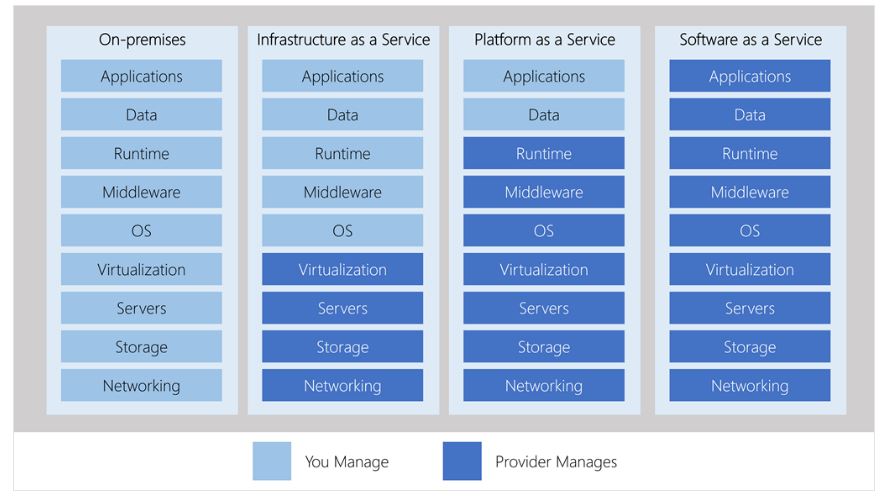
Expert’s Corner
To conclude, MS-900 is a chance to generate a golden bowl for yourself which can help you achieve your dream goals. As we all know, the pace of life is quickly in modern society, therefore, we must squeeze time to learn and become better. After all, everybody strives to become a better version of themselves.
Our Microsoft MS-900 Cheat Sheet is designed in such a manner that it will not occupy your much time. In other words, whenever you have spare time, you can have a quick glance at our Microsoft MS-900 exam simulation. Also, gradually, you will acquire and learn much knowledge and become totally different from the past.
Our website offers customer service to assist you, in case you may get some problems in the MS-900 Cheat Sheet. Feel free to drop your questions. We are happy to help!
Grow your certification portfolio with advanced learning skills and expert tutorials on Microsoft 365 Fundamentals (MS-900) Exam. Prepare and become a Certified Now!

